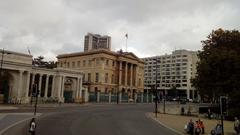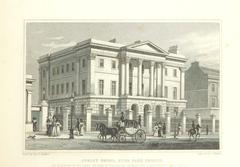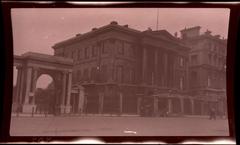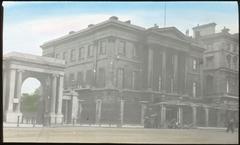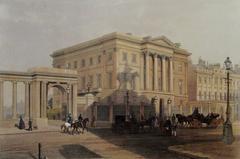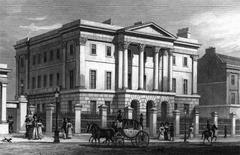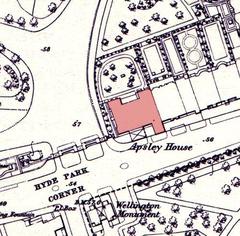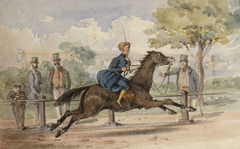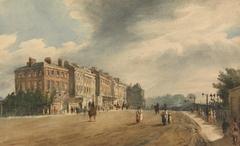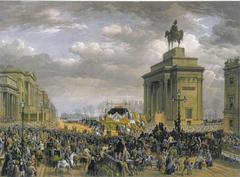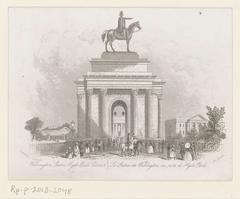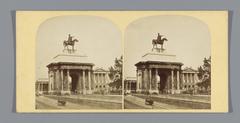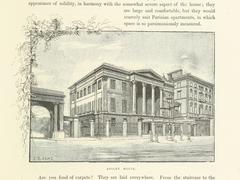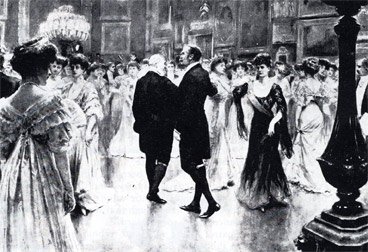
A Complete Guide to Apsley House: Visiting Hours, Tickets, and Historical Significance in London
Date: 14/06/2025
Introduction
Apsley House, often referred to as “Number One, London,” stands as one of the city’s most distinguished historical sites. Located at 149 Piccadilly, Hyde Park Corner, this grand neoclassical townhouse once served as the London residence of Arthur Wellesley, the 1st Duke of Wellington. Not only does it represent a masterpiece of Georgian and Regency architecture, but it also houses the internationally renowned Wellington Collection, featuring works by artists such as Velázquez, Rubens, and Goya. Today, Apsley House offers a captivating journey through British history, art, and culture, making it an essential stop for history enthusiasts, art lovers, and travelers alike (English Heritage; Wellington Collection).
Historical Background
Origins and Architectural Development
Built between 1771 and 1778 for Henry Bathurst, 1st Baron Apsley, by acclaimed architect Robert Adam, Apsley House originally featured a red-brick neoclassical façade. Adam’s vision incorporated elegant proportions and classical detailing, setting the tone for one of London’s most elite residences (Britain Express).
Acquisition and Transformation by the Duke of Wellington
After his victory at the Battle of Waterloo in 1815, the 1st Duke of Wellington purchased Apsley House in 1817. Under the direction of Benjamin Dean Wyatt, the house underwent extensive remodeling to accommodate Wellington’s elevated status. Notable additions included the grand Waterloo Gallery, lavish Regency interiors, and a Bath stone façade, establishing the property as a quintessential symbol of British aristocracy and military triumph (English Heritage; Victorian Web).
The Wellington Collection
Apsley House is home to the Wellington Collection, an internationally significant assembly of nearly 1,000 artworks and diplomatic treasures. The collection includes masterpieces by Velázquez, Rubens, Goya, Titian, and Breughel, as well as remarkable silver and porcelain gifts from European monarchs (Wellington Collection; English Heritage).
Architectural Evolution and Significance
Exterior Features and Urban Setting
Positioned at Hyde Park Corner, Apsley House occupies a prestigious location adjacent to Wellington Arch. Wyatt’s transformation refaced the house with Bath stone and added a grand portico, while the surrounding cast iron railings and formal gates unify the property with the city’s ceremonial landscape (Victorian Web).
Interior Design and Decorative Arts
- Robert Adam’s Neoclassical Vision: Adam’s original interiors, emphasizing light and harmony, survive in the layout and room proportions.
- Wyatt’s Regency Transformation: Wyatt introduced opulent Regency décor, gilded panelling, and ornate ironwork. The highlight is the Waterloo Gallery, designed for lavish banquets, with mirrored walls and an intricately decorated ceiling (Victorian Web).
- State Dining Room and Drawing Rooms: These rooms feature period furnishings, grand chandeliers, and significant artworks, including Sir William Allan’s “The Battle of Waterloo.”
Integration of Art and Architecture
Apsley House is both a private residence and museum, displaying Old Master paintings, fine porcelain, silver, and sculptures, including the iconic statue of Napoleon by Canova (MyLondonPass).
Monumental Context
The alignment with Wellington Arch and nearby monuments underscores Apsley House’s role as a focal point of national memory and British pride (Victorian Web).
Visiting Apsley House: Essential Information
Opening Hours and Visiting Days
Apsley House is typically open to visitors from Tuesday to Sunday, 10:00 AM to 5:00 PM (last entry at 4:30 PM). Hours may vary seasonally and during special events, so it’s best to check the official English Heritage website before your visit.
Ticket Prices and Booking
- Adults: £15
- Concessions: £13
- Children under 16: Free
- Family tickets and annual passes: Available
Tickets can be purchased online or on-site, but advance booking is recommended during peak periods.
Accessibility
Apsley House is committed to accessibility, offering step-free access to most public areas, a lift to main reception rooms, and accessible restrooms. Some upper floors and the basement may have limited access due to the building’s historic nature. Assistance dogs are welcome, and additional resources such as large-print guides are available.
Guided Tours and Special Events
Regular guided tours led by expert staff provide in-depth insights into the house’s history and collections. Special events, including Waterloo Banquet reenactments and themed tours, are held throughout the year (Event Details).
Travel Tips and Nearby Attractions
Apsley House is ideally located near Hyde Park, Wellington Arch, and Buckingham Palace. The nearest tube station is Hyde Park Corner (Piccadilly Line), and several bus routes serve the area. Plan at least 1.5 to 2 hours for your visit.
Highlights of the Visitor Experience
Key Rooms and Exhibits
- Waterloo Gallery: The most celebrated space, hosting the annual banquet commemorating the Battle of Waterloo. Its gilded décor and art collection are must-sees.
- State Dining Room: Set with silver-gilt plate and porcelain, evoking 19th-century grandeur.
- Museum Room: Displays Wellington’s military memorabilia, medals, and the Portuguese Service.
- Grand Staircase and Entrance Hall: Make a dramatic first impression with their Regency-era ironwork and statuary.
- Art Collection: Masterpieces by Velázquez, Rubens, Goya, and others, many of which were diplomatic gifts.
Interpretation and Displays
Apsley House’s interiors are restored to reflect the Regency era, with period furnishings and décor. Informational panels, audio guides, and multimedia displays bring the house’s stories to life.
Family and Group Visits
Families can enjoy activity trails for children, while group tours and educational programs are also available.
Photography
Photography is allowed (without flash or tripods) in most areas. The Waterloo Gallery and south façade offer especially striking photo opportunities.
Frequently Asked Questions (FAQ)
Q: What are Apsley House’s opening hours?
A: Typically Tuesday–Sunday, 10:00 AM–5:00 PM (last entry 4:30 PM), closed Mondays and public holidays.
Q: How much do tickets cost?
A: Around £15 for adults, with concessions and free entry for children under 16.
Q: Is Apsley House wheelchair accessible?
A: Yes, most public areas are accessible; a lift is available to main rooms.
Q: Are guided tours available?
A: Yes, regular guided tours and audio guides are offered.
Q: Are there dining facilities?
A: No on-site café, but many dining options are nearby.
Travel Recommendations and Practical Tips
- Book tickets in advance for peak times or special events.
- Visit on weekdays to avoid crowds.
- Combine your visit with nearby attractions like Wellington Arch and Hyde Park.
- Allow 1.5–2 hours for a full tour.
- Check the English Heritage website for current exhibitions and events.
- Use public transport as parking is limited.
Visuals and Media
Explore Apsley House through high-quality images and multimedia guides available on the English Heritage website. Alt text and SEO-optimized captions such as “Apsley House London façade,” “Regency interior,” and “Duke of Wellington art collection” enhance accessibility and searchability.
Enhance Your Visit
Download the Audiala app for immersive audio guides, interactive maps, and exclusive content about Apsley House and other London historical sites. Stay up to date with special events and exhibitions by following English Heritage and Audiala on social media.
Conclusion
Apsley House stands as a premier London historical site that blends architectural splendor, remarkable collections, and profound historical significance. From its neoclassical origins to its transformation under the Duke of Wellington, the house offers a unique window into Regency London and British national memory. Whether your interests lie in architecture, art, or military history, Apsley House promises a rewarding and educational experience.
Sources
- English Heritage. (n.d.). Apsley House. Retrieved from https://www.english-heritage.org.uk/visit/places/apsley-house/
- Wellington Collection. (n.d.). About the Wellington Collection. Retrieved from https://www.wellingtoncollection.co.uk/about/
- Britain Express. (n.d.). Apsley House. Retrieved from https://www.britainexpress.com/London/Apsley_House.htm
- Victorian Web. (n.d.). Apsley House Architecture. Retrieved from https://victorianweb.org/art/architecture/london/95.html
- Museums London. (n.d.). Apsley House - Wellington Museum. Retrieved from https://www.museumslondon.org/museum/35/apsley-house-wellington-museum

